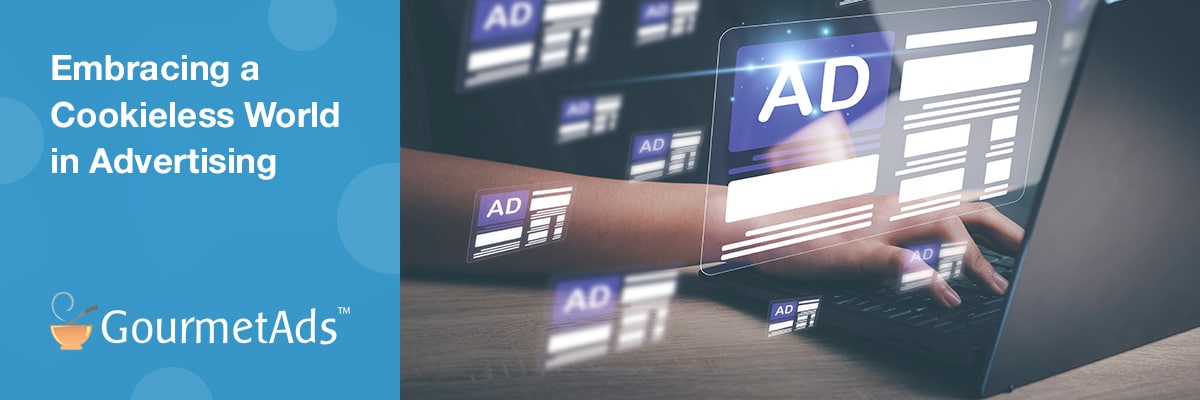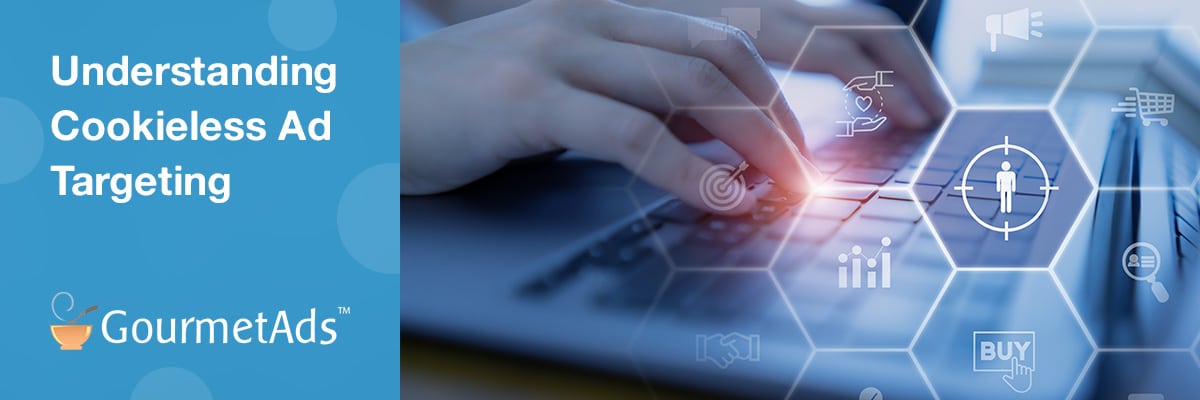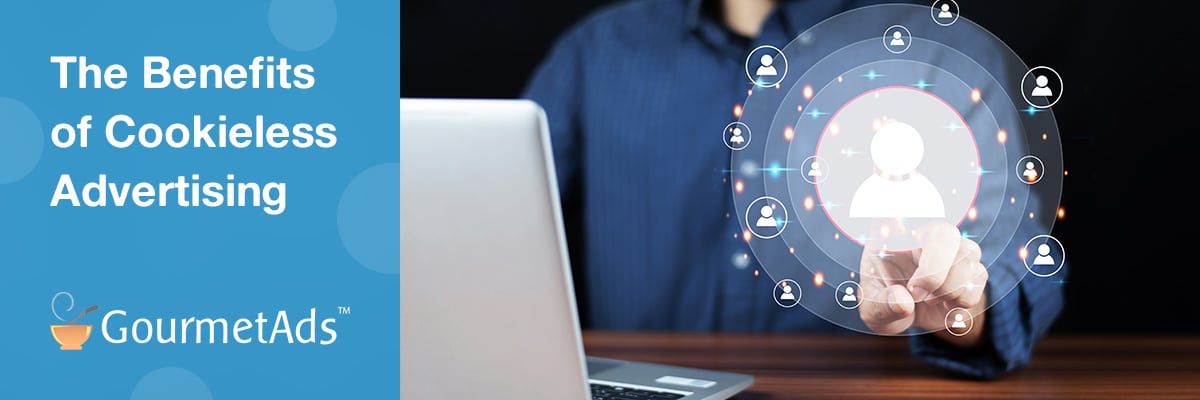- To successfully transition to a cookieless future, businesses must prioritize first-party data and privacy-centric marketing tactics.
- To prepare for the cookieless transition, strengthen first-party data collection, enhance user trust, and embrace new advertising methods.
- A cookieless advertising setting improves user privacy, transparency, and innovation prospects.
The absence of third-party cookies in the future has recently gained popularity as digital marketing develops. Companies face challenges during this transformation, but they also have an opportunity to reconsider advertising practices and prioritize consumer privacy. This article will explore the reasons behind this transition in more detail and point out strategies that businesses can use to adapt to the cookieless world, such as using no-cookie advertisements.
Embracing the Cookieless World in Advertising

The cookieless future refers to the elimination of third-party cookies as a result of Google’s announcement to remove them from its Chrome browser. Businesses and marketers must prioritize first-party data strategies and look for privacy-conscious techniques if they want to keep up with this new digital world. In order to do this, it is necessary to build stronger customer relationships through techniques like user behavior tracking that goes beyond relying solely on cookies, shift to alternative signals for website owners who design user journeys around customers, and investigate how organizations can use their own information sets (first party data) in the online market environment. When implementing a cookie-free environment moving ahead, all these changes will provide a variety of issues that require careful examination.
The Rise of First-Party Data
First party data is now more important than ever for companies to be able to grow their client base while complying with the relevant privacy regulations as third-party cookies continue to be phased out. This type of data, which is directly gathered by a company from its own customer base, includes website analytics and CRM procedures that, when combined with other sources like an identity graph, offer insightful information about the purchases made across different devices owned by a customer.
First-party cookies are advantageous because they do not track online activity on other websites after being created on the visited domain. Delivering a customized experience in place of one depending on user preferences, such as language settings or products in carts that require login information to access. As an alternative to cookie-targeted advertising, John Busbice believes there is potential in combining first-data with efficient entity graphs that are enhanced by probabilistic scoring models. When data management and analytical ability are combined, operations may be improved and decisions for consumer outreach can be informed by using the right measurement system design and using the gathered, securely stored data.
Privacy-Centric Marketing Approaches
Using a privacy-centric marketing approach is a good method to win clients’ trust. Businesses can deliver customized advertising that caters to their customers’ preferences without using invasive monitoring techniques or breaking any privacy laws by respecting user consent and using first party data. They are able to develop personalized experiences while safeguarding the privacy of the customer by using transparent business practices. This strategy not only strengthens consumer-business ties but also ensures compliance with data protection regulations.
Understanding Cookieless Ad Targeting

Marketers are turning their attention to cookieless ad targeting as a substitute strategy as a result of the phase-out of third-party cookies. Cookieless tracking is a marketing tactic that reduces reliance on web-collected data and uses alternative identifiers and signals, such as contextual advertising and FLoC and Google’s Privacy Sandbox, to deliver customized advertisements without utilizing such data. By ensuring that important messages still reach intended users—who might not be fully identifiable through cookie collection alone due to cohorting techniques used in conjunction with relevant context provided via these strategies—such measures can help businesses get ready for this evolving “cookieless future.”
Contextual Advertising
Ads can be customized using contextual advertising based on the content of a page, avoiding tracking techniques that don’t respect users’ privacy. By concentrating on this strategy rather than relying on cookies, businesses will still have access to targeted and relevant advertisements, despite increasing concerns over the usage of third party cookies. Contextual advertising plays an important role in enabling firms to engage with their desired clients as digital marketing develops without breaching individuals’ personal information or data security. By always respecting user privacy, these strategies also guarantee that personalized advertisements are delivered.
Alternate Identifiers and Signals
In order to identify users while maintaining their privacy, personal identifiers like hashed emails and mobile ad IDs are used. As a result, companies can offer tailored marketing interactions without relying on third-party cookies. For businesses trying to make the transition to a cookie-free world where they can still effectively reach clients with customized ads, the usage of these alternative tracking techniques is essential. In order to keep user data private in the face of ongoing privacy rule changes, other identities are becoming more and more important in the digital advertising sector.
Google’s Privacy Sandbox and FLoC
Google’s Privacy Sandbox and FLoC (Federated Learning of Cohorts) are intended to provide targeted advertisements while protecting user privacy. This technique divides users into cohorts based on their interests without revealing their names, enabling personalized consent-based targeting. Businesses must keep up to date on these technologies as they move away from relying on third-party cookies in the cookieless future. Using this unique method will generate advertising breakthroughs that allow organizations and audiences to stay connected without affecting data security or confidentiality.
Preparing Your Business for the Cookieless Future

By concentrating on data gathering, fostering client trust, and becoming familiar with new technologies, businesses must be prepared to handle the cookieless transition. Companies need to change their approaches in order to properly plan for what lies ahead in a “cookieless” future as third-party cookies become extinct. Businesses can benefit from this change rather than face difficulties by putting proactive measures in place like gathering first party data or privacy protocols that may affect operations.
In order to succeed in digital marketing today, businesses should focus on educating their clients about the services they offer. Being open and honest about customer interactions and consumer security, improving through innovations that put user trust & safety first, and staying informed about modern techniques utilized by exclusive advertisers, etc. These actions will set the foundation for prosperous business opportunities even if the industry is moving into an uncertain environment without using any type of external tracking systems associated with other sites, also known as 3rd-Party Cookies, which were used years ago primarily due to their invisibility/tracking abilities and are no longer accepted by users/consumers across the Internet!
Strengthening First-Party Data Collection
To remain competitive in the ever-changing world of digital marketing, organizations must focus on gathering accurate customer data and establishing a strong first-party data collection system. This includes using website analytics, CRM procedures, and transparency to achieve the greatest degree of success as well as collecting reliable identifiers like email addresses or phone numbers with customers’ consent. It is essential that businesses use this technique of getting personalized information because cookies are becoming less trustworthy sources of information in an increasingly cookie-free future. This will allow businesses to develop experiences for each individual customer while always respecting that consumer’s privacy rights.
Building Trust and Transparency with Users

Businesses must build customer confidence and transparency, especially in the world of digital marketing as it continues to transition to a cookieless future. This implies that businesses must offer transparent privacy rules that spell out exactly what information they are gathering, how they intend to use it, and where it will be stored. Users should be able to choose not to participate in any data collection processes or changes made to their personal data protection policies, allowing businesses to maintain close relationships with clients and achieve both essential privacy compliance requirements and client loyalty.
Adapting to New Advertising Technologies and Platforms
If businesses want to stay competitive in the realm of digital marketing, they must stay on top of emerging trends and be open to experimenting with new advertising technology. Businesses that want to succeed in a world without cookies must stay on top of new developments since doing so will let them engage with clients on more individualized platforms while respecting privacy regulations. It’s important to conduct relevant research, test out various strategies, update methods for communication with the help of information gained from evaluation procedures, and seek assistance as necessary if you want to ensure that your firm can adapt appropriately. After that, keep an eye on the progress while maintaining your commitment to addressing consumer needs.
The Benefits of Cookieless Advertising

There are many benefits for both organizations and users in moving away from third-party cookies and towards a cookieless advertising environment. Businesses have the option to use innovative marketing strategies that put customer privacy first while developing stronger connections with their clients allowing them to finally take digital marketing more seriously than before. In terms of user advantages, improved client interactions and protection over personal information are promised, which promotes loyalty and trust in the products and services provided by businesses in this industry. This transition also gives an opportunity for innovation in new techniques of personalized advertising without sacrificing respect for user privacy, which is essential in this case.
Enhanced User Privacy
Users will benefit from enhanced privacy when companies switch to using first-party data and away from intrusive tracking techniques. By giving users greater control over their personal information, such as by giving them access to tools that manage it in accordance with the GDPR regulations and other protocols of data protection principles. They can choose how their data is used with greater knowledge. Prioritizing client privacy in digital marketing enables businesses to improve customer connections by providing a personalized experience that respects consent while adhering to various applicable rules on confidentiality issues.
Ultimately, stronger user security measures are required for every business or organization seeking an advantage in today’s digital market setting, which increases competitiveness in the area.
More Transparent Customer Relationships
Businesses may create better connections with customers by being transparent about data collection and usage when trust and consent are at the heart of their relationship. This allows them to provide opt-in or opt-out alternatives for users while also giving the customer control over their own information. As a result, customer loyalty, engagement, and satisfaction improve while offering invaluable insight into user behavior, which is becoming increasingly important in a cookie-free future digital marketing world. Companies must be honest in order to sustain effective client interactions in the future through online tactics such as those used in digital marketing operations.
Encouraging Innovation in Advertising
Businesses are adopting digital advertising technologies such as first-party data and contextual advertising as a result of the cookieless future. This provides an opportunity for them to create trust with clients by experimenting with privacy-first approaches. Businesses can improve their chances of success in this new era by innovating in the rapidly evolving field of digital marketing.
In order to provide personalized experiences without using third-party cookies, first-party data collecting gives businesses the chance to connect with users effectively while protecting their privacy. Other alternative identifiers or signals are being created as part of Google’s Privacy Sandbox and FLoC initiatives, and they provide alternatives for gathering consumer information in the future while maintaining privacy.
Adopting innovative strategies for avoiding cookie tracking will allow corporations to significantly improve their relationships with users because they are no longer limited by traditional forms of advertising like before, but rather have numerous options for effectively reaching target audiences while respecting respective users’ rights over personal data usage.
Summary
Businesses will face advantages and challenges in the cookie-free future. By emphasizing first-party data collection methods, adjusting to privacy-focused marketing practices, and implementing alternate ad targeting techniques. Companies can gain from higher user protection standards while building more open interactions with customers that encourage innovation in their advertising ventures. Even without access to third-party cookies, success is possible with knowledge of this changing environment.











